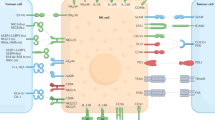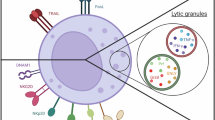Abstract
Natural killer (NK) cells have been known for many years as the lymphocyte subset characterized by the highest cytolytic potential against virus-infected and tumor-transformed cells. A surprisingly high number of surface molecules have been recognized that regulate human NK cell function. These include MHC-specific inhibitory receptors, which impair NK cells’ ability to attack normal self-tissues, and activating receptors and coreceptors that allowthemto recognize and kill transformed cells. The recent identification of some of the cellular ligands specifically recognized by these receptors/coreceptors contributes to elucidation of the mystery of the role played by NK cells in immune responses.
Access this chapter
Tax calculation will be finalised at checkout
Purchases are for personal use only
Preview
Unable to display preview. Download preview PDF.
Similar content being viewed by others
References
Biron, C.A. et al. (1999) Natural killer cells in antiviral defense: function and regulation by innate cytokines. Annu. Rev. Immunol. 17, 189–220.
Parham, P. (2003) Immunogenetics of killer-cell immunoglobulin-like receptors. Tissue Antigens 62, 194–200.
Moretta, L. and Moretta, A. (2004) Killer immunoglobulin-like receptors. Curr. Opin. Immunol. 16, 626–633.
Lopez-Botet, M. et al. (2000) NK cell recognition of non-classical HLA class I molecules. Semin. Immunol. 12, 109–119.
Algarra, I. et al. (2004) The selection of tumor variants with altered expression of classical and nonclassical MHC class Imolecules: implications for tumor immune escape. Cancer Immunol. Immunother. 53, 904–910.
Alcami, A. and Koszinowski, U.H. (2000) Viral mechanisms of immune evasion. Immunol. Today 21, 447–455.
Moretta, A. et al. (2001) Activating receptors and coreceptors involved in human natural killer cell-mediated cytolysis. Annu. Rev. Immunol. 19, 197–223.
Lanier, L.L. (2003) Natural killer cell receptor signaling. Curr. Opin. Immunol. 15, 308–314.
Bottino C. et al. (2005) Cellular ligands of activating NK receptors. Trends Immunol. 26, 221–226.
Moretta, A. et al. (2000) Natural cytotoxicity receptors that trigger human NK-mediated cytolysis. Immunol. Today 21, 228–234.
Augugliaro, R. et al. (2003) Selective cross-talk among natural cytotoxicity receptors in human natural killer cells. Eur. J. Immunol. 33, 1235–1241.
Sivori, S. et al. (2000) Involvement of natural cytotoxicity receptors in human natural killer cell mediated lysis of neuroblastoma and glyoblastoma cell lines. J. Neuroimmunol. 107, 220–225.
Castriconi, R. et al. (2004) Natural killer cell-mediated killing of freshly isolated neuroblastoma cells: critical role of DNAM-1/PVR interaction. Cancer Res. 64, 9180–9184.
Pende, D. et al. (2005) Analysis of the receptor-ligand interactions in the natural killer-mediated lysis of freshly isolated myeloid or lymphoblastic leukemias: evidence for the involvement of the Poliovirus receptor (CD155) and Nectin-2 (CD112). Blood 105, 2066–2073.
Nowbakht, P. et al. (2005) Ligands for natural killer cell-activating receptors are expressed upon the maturation of normal myelomonocytic cells but at low levels in acute myeloid leukemias. Blood 105, 3615–3622.
Moretta, A. (2002) Natural killer cells and dendritic cells: rendezvous in abused tissues. Nat. Rev. Immunol. 2, 957–964.
Sivori, S. et al. (2000) 2B4 functions as a co-receptor in human natural killer cell activation. Eur. J. Immunol. 30, 787–793.
Bottino, C. et al. (2001) NTB-A, a novel SH2D1A-associated surface molecule contributing to the inability of natural killer cells to kill Epstein-Barr virus-infected B cells in X-linked lymphoproliferative diseases. J. Exp. Med. 194, 235–246.
Vitale, M. et al. (2001) Identification of NKp80, a novel triggering molecule expressed by human natural killer cells. Eur. J. Immunol. 31, 233–242
Marcenaro, E. et al. (2003) CD59 is physically and functionally associated with natural cytotoxicity receptors and activates human NK cell-mediated cytotoxicity. Eur. J. Immunol. 33, 3367–3376.
Nakajima, H. et al. (1999) Activating interactions in human NK cell recognition: the role of 2B4-CD48. Eur J Immunol. 29, 1676–1683.
Falco, M. et al. (2004) Homophilic interaction of NTBA, a member of the CD2 molecular family: induction of cytotoxicity and cytokine release in human NK cells. Eur J Immunol. 34, 1663–1672.
Parolini, S. et al. (2000) X-linked lymphoproliferative disease: 2B4 molecules displaying inhibitory rather than activating function are responsible for the inability of NK cells to kill EBV-infected cells. J. Exp. Med. 192, 337–346.
Eissmann, P. et al. (2005) Molecular basis for positive and negative signaling by the natural killer cell receptor 2B4 (CD244). Blood 105, 4722–4729.
Loic, D. et al. (2005) SAP controls the cytolytic activity of CD8+ T cells against EBV-infected cells. DOI 10.1182/blood-2004-08-3269
Sivori S. et al. (2002) Early expression of triggering receptors and regulatory role of 2B4 in human NK cell precursors undergoing in vitro differentiation. P. Natl. Acad. Sci. USA 99, 4526–4531.
Bottino C, et al. (2000) Analysis of the molecular mechanism involved in 2B4-mediated NK cell activation: evidence that human 2B4 is physically and functionally associated with the linker for activation of T cells (LAT). Eur. J. Immunol. 30, 3718–3722.
Li, P., et al., 2001. Complex structure of the activating immunoreceptor NKG2D and its MHC class I-like ligand MICA. Nat. Immunol. 2, 443–451.
Cosman, D., et al., 2001. ULBPs, novel MHC class I-related molecules, bind to CMV glycoprotein UL16 and stimulate NK cytotoxicity through the NKG2D receptor. Immunity 14, 123–133.
Cerwenka, A. and Lanier, L.L. (2003) NKG2D ligands: unconventional MHC class I-like molecules exploited by viruses and cancer. Tissue Antigens 61, 335–343.
Diefenbach, A. et al. (2002) Selective associations with signaling proteins determine stimulatory versus costimulatory activity of NKG2D. Nat Immunol. 3, 1142–1149.
Zompi, S. et al. (2003) NKG2D triggers cytotoxicity in mouse NK cells lacking DAP12 or Syk family kinases. Nat Immunol. 4, 565–572
Andre, P. et al. (2004) Comparative analysis of human NK cell activation induced by NKG2D and natural cytotoxicity receptors. Eur. J. Immunol. 34, 961–971.
Bottino, C. et al. (2003) Identification of PVR (CD155) and Nectin-2 (CD112) as cell surface ligands for the human DNAM-1 (CD226) activating molecule. J. Exp. Med. 198, 557–567.
Kojima, H., et al (2003) CD226 mediates platelet and megakaryocytic cell adhesion to vascular endothelial cells. J. Biol. Chem. 278:36748–36753.
Reymond, N. et al. (2004) DNAM-1 and PVR regulate monocyte migration through endothelial junctions. J. Exp. Med. 199, 1331–1341.
Oda T. et al. (2004) Ligand stimulation of CD155a inhibits cell adhesion and enhances migration of fibroblasts. Biochem. Biophys. Res. Commun. 319, 1253–1264.
Barber, D.F. et al. (2004) LFA-1 contributes an early signal for NK cell cytotoxicity. J. Immunol. 173, 3653–3659.
Author information
Authors and Affiliations
Corresponding author
Editor information
Editors and Affiliations
Rights and permissions
Copyright information
© 2006 Springer-Verlag Berlin Heidelberg
About this chapter
Cite this chapter
Bottino, C., Moretta, L., Moretta, A. (2006). NK Cell Activating Receptors and Tumor Recognition in Humans. In: Compans, R., et al. Immunobiology of Natural Killer Cell Receptors. Current Topics in Microbiology and Immunology, vol 298. Springer, Berlin, Heidelberg. https://doi.org/10.1007/3-540-27743-9_9
Download citation
DOI: https://doi.org/10.1007/3-540-27743-9_9
Publisher Name: Springer, Berlin, Heidelberg
Print ISBN: 978-3-540-26083-7
Online ISBN: 978-3-540-27743-9
eBook Packages: Biomedical and Life SciencesBiomedical and Life Sciences (R0)




